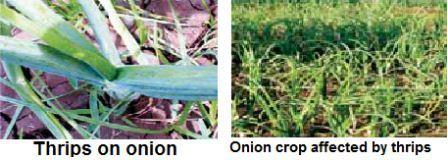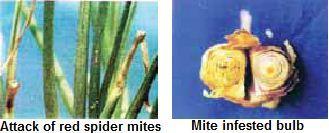Onion: Insect and Mite Pests Management
Onion: Insect and Mite Pests Management
Onion thrips
Biology- Egg: White to yellow, kidney-bean shaped, microscopic in size. Develop within leaf tissue with one end near the leaf surface. Egg stage is 5-10 days.
- Larva: Instars I and II are active, feeding stages. White to pale yellow, elongate and slender body. Resemble adult, but without wings. Antennae are short and eyes are dark in color. Feed on new leaves in the center of the onion neck. Crawl quickly when disturbed. Larval stage is 10-14 days.
- Pre-pupa and pupa: Instars III and IV are inactive, non-feeding stages called pre-pupa and pupa. Pale yellow to brown; body more stout than younger instars. Antennae are bent to head; wing buds are visible. Found in the soil, at the base of the onion plant neck, or underneath bulb scales. Lasts 5-10 days.
- Adult: About 1.5 mm long; elongate, yellow and brown body with two pairs of fringed (hairy) wings. Mouthparts are beak-like and antennae are 7-segmented. Spend the winter in protected sites under plants and debris in onion, alfalfa and small grain fields, and other plant habitats. In the spring when temperatures warm, adults fly to new onion fields. Parthenogenic (asexually reproducing) females; males are extremely rare. Feed on young leaves in center of onion neck and insert eggs individually into leaves. Fly readily when disturbed. Adult life span is about 1 month; pre-oviposition period (time before egg-laying begins) is 1 week and females will lay eggs for about 3 Weeks
 Both adult and larval thrips feed within the mesophyll layer using a punch-and suck motion.
Both adult and larval thrips feed within the mesophyll layer using a punch-and suck motion.- The beak and mandible is thrust forward to puncture the leaf epidermis and sap released from injured plant cells is sucked up.
- Removal of chlorophyll causes the feeding area to appear white to silvery in color.
- Areas of leaf injury can occur as patches and streaks.
- When feeding injury is severe, leaves take on a silvery cast and can wither.
- Tiny black “tar” spots of thrips excrement are evident on leaves with heavy feeding injury.
Onion maggot
Biology- Egg: The onion fly deposits white elongated eggs. About 1/25 inch (I.25mm) in length on the soil near the stem and occasionally on the young leaves and neck of the onion plant Eggs hatch into maggots 2-3 days after being laid.
- Maggot: The legless maggots are tapered, creamy-white in color, and reach a length of about 1/3 inch (8mm). Maggots develop through three larval stages in 2 to 4 weeks depending on the temperature. Most newly hatched larvae crawl below the soil surface and feed upon the roots or burrow into the basal plate of the bulbs. Some maggot larvae may enter into the sides of bulbs rather than through the basal plate, after undercutting has occurred. Any injury site on the bulb facilitates the maggot’s entry.
- Pupa: When full-sized, the maggot leaves the bulb and enters the soil to pupate at a depth of 1-4 inches (5-10 cm). The pupa is chestnut brown and 1/3 inch (7mm) long. First and second generation pupae remain in the soil for 2-4 weeks before adult emergence. Larvae of the third (fall) generation develop into pupae and pass the winter in that stage. Flies emerging the following spring constitute the spring flight.
- Adult: Onion flies are slightly smaller than house flies. They have longer legs, are more slender, and overlap their wings when at rest.
- Only the larva causes damage by using its hooked mouth parts to enter the base of the plant.
- Damaged seedlings first wilt, eventually become flaccid, and die.
- Frequently, attacked seedlings die before the maggots are fully grown, forcing them to move to adjacent plants.
- Second generation maggot feeding on developing bulbs usually results in distorted growth accompanied by rotting tissue.
- Feeding by third generation maggots on late season onion bulbs results in an unmarketable product
Red spider mite
BiologyThe carmine spider mite normally completes a life cycle from egg to adult in about a week. All stages of this mite are present throughput the year. Reproduction is most favorable when the weather is hot and dry.
- Egg: Eggs are spherical, shiny, straw colored, and hatch in 3 days. They are only about 1/254 inch in diameter. They are laid singly on the underside of the leaf surface or attached to the silken webs spun by the adults.
- Larva: Larvae are slightly larger than the egg, pinkish, and have three pairs of legs. This stage lasts a short time, perhaps a day.
- Nymph: There are two nymphal stages, the protonymph and deutonymph. The nymphal stage differs from the larval stage by being slightly larger, reddish or greenish, and having 4 pairs of legs. This nymphal stage lasts about 4 days.
- Adult: Adult females are about 1/50 inch long, reddish, and more or less elliptical. The males are slightly smaller and wedge shaped. They have a black spot on either side of their relatively colorless bodies. The adult female may live for up to 24 days and lay 200 eggs.
 Adults and nymphs feed primarily on the undersides of the leaves.
Adults and nymphs feed primarily on the undersides of the leaves.- The upper surface of the leaves becomes stippled with little dots that are the feeding punctures.
- The mites tend to feed in “pockets” often near the midrib and veins.
- Silk webbing produced by these mites is usually visible.
- The leaves eventually become bleached and discolored and may fall off.
Bulb mite
BiologyThe developmental stages in the life cycle are egg, larva, protonymph, heteromorphic deutonymph, tritonymph and adult.
- Egg: Females lay up to 700 eggs each depending on the host. The eggs mature in 3 to 5 days. The egg is white and translucent, 0.12 mm long, and ellipsoidal.
- Larva: Larval period is 3 to 7 days. The protonymph period 3 to 5 days. This stage can be distinguished from the tritonymph by having two genital suckers, whereas the tritonymph has three or four suckers. Deutonymph or Hypopus- This quiescent stage is oval, convex on top, flattened below, brown, and 0.2 to 0.3 mm long. The ntritonymph is about 0.5 mm in length and has not yet developed a distinct genital aperture. Hypopi form when the population becomes crowded, or the substrate becomes too polluted by decay. The hypopal stage attaches to insects visiting the bulbs and may be carried to other bulbs.
- Adult: The longevity male adult is 62 days and female is 31 days. Mature bulb mites vary from 0.5 to 0.9 mm long and have four pairs of legs. Their bodies are shiny, white, somewhat transparent, and smooth with reddish brown appendages. The total life cycle from egg to adult could be as short as 12.2 days (at 25°C)
- Bulbs infested with bulb mites may rot and fail to produce new growth, or new growth may be off color, stunted, and distorted.
- Although the bulb mite is not considered a primary pest of bulbs, it is often responsible for serious losses; the slightest injury to a bulb will allow bulb mites to enter and become established.
- Once the mites are inside the bulb, they rapidly turn the bulbs into rotten pulp.
- Infestations of the bulb mite generally indicate that the bulbs have already been injured.
- This damage could have been caused by other pests, such as the bulb scale mite or bulb flies, mechanical injury, or improper storage.
- The root primordia of freesia and gladiolus may be bruised at planting.
- Apparently bulb mites can attack healthy new roots and corms, especially in greenhouses. The mites may penetrate into lily stems which become brittle. Infested lilies are often dwarfed, distorted, and the stem roots are suppressed.
- Bulb mites may enter prematurely opened tulip buds (due to high storage temperatures or ethylene generated by diseased bulbs in storage) and cause bud necrosis.
Eriophyid mite
BiologyThe life cycle is composed of the egg, the larva, two nymphal stages (protonymph and deutonymph) and the adult.
- Egg: Egg incubation period 2-4 days; the eggs are attached to fi ne silk webbing and hatch in approximately three days.
- Nymph: Protonymphal and deutonymphal period is 2 to 3 days, each.
- Adult: Adult mites survive about 8 days. Length 200 to 250 μm and width 36 to 52 μm, The adult female is capable of laying several hundred eggs during her life. Total life cycle 7 to 9 days. The length of time from egg to adult varies greatly depending on temperature.
- Both adults and immature feed on the young leaves and between the layers in bulbs of onion
- Their feeding causes stunting, twisting, curling and discoloration of foliage and scarification and drying of bulb tissue
- This damage has been attributed to various viruses thought to be transmitted by the mites
IPM for Onion
To know the IPM practices for Onion, click here.
Source: NIPHM and Directorate of Plant Protection, Quarantine & Storage
Last Modified : 1/14/2020
This topic information covers about Lablab bean - ...
This topic covers the information related to Insec...
This topic covers information about Description of...
This topic covers the information related to Insec...
